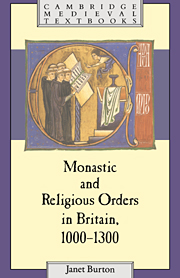Book contents
- Frontmatter
- Contents
- List of illustrations
- Preface
- 1 Before the Normans
- 2 The coming of the Normans
- 3 The regular canons
- 4 The new monastic orders of the twelfth century
- 5 Women and the religious life
- 6 The mendicant orders
- 7 The physical setting: monastic buildings and the monastic plan
- 8 Inside a religious house: daily life and the chain of command
- 9 Learning and literary activities
- 10 Religious houses and the wider community: founders, patrons and benefactors
- 11 The monastic economy
- 12 On the brink of change
- Glossary
- Notes
- Select bibliography
- Index
- Cambridge Medieval Textbooks
12 - On the brink of change
Published online by Cambridge University Press: 05 June 2012
- Frontmatter
- Contents
- List of illustrations
- Preface
- 1 Before the Normans
- 2 The coming of the Normans
- 3 The regular canons
- 4 The new monastic orders of the twelfth century
- 5 Women and the religious life
- 6 The mendicant orders
- 7 The physical setting: monastic buildings and the monastic plan
- 8 Inside a religious house: daily life and the chain of command
- 9 Learning and literary activities
- 10 Religious houses and the wider community: founders, patrons and benefactors
- 11 The monastic economy
- 12 On the brink of change
- Glossary
- Notes
- Select bibliography
- Index
- Cambridge Medieval Textbooks
Summary
The subject of this study has been the monastic and religious orders in Britain, but it may be useful to conclude by re-emphasizing that Britain was not isolated from trends in western Christendom as a whole. The period to which this work is devoted saw many changes in the concept and practice of the monastic life of Europe. Intellectual developments, social and economic change and notions of ecclesiastical reform all contributed to an explosion of new types of religious practice which were manifest in a proliferation of religious houses for both men and women. As the twelfth century dawned and developed, the pursuit of a religious vocation was no longer limited to a choice between the solitary existence of a hermit and the largely aristocratic ambience of a monastery or nunnery following the Rule of St Benedict, perhaps with the addition of customs derived from one of the centres of reform, like Cluny or Fleury. Monasticism now embraced a much wider range of ideals and practices which had fused the eremitical spirit of primitive monasticism with the concept of community – for monasticism is, perhaps above all, about community. With the friars came yet more novelty, the realization that life according to a religious vow and rule need not be lived within the confines of the cloister but could be evangelical, not contemplative, outward-, not inward-looking.
- Type
- Chapter
- Information
- Monastic and Religious Orders in Britain, 1000–1300 , pp. 264 - 268Publisher: Cambridge University PressPrint publication year: 1994

